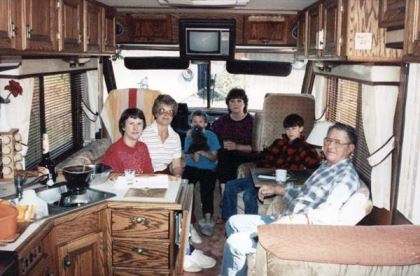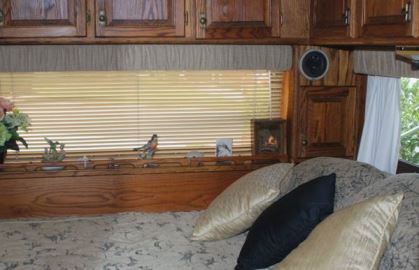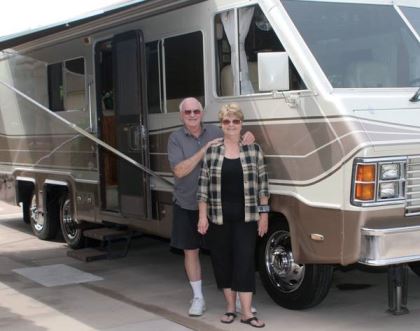When their beautifully tended vintage motorhome began to show its years, a California couple resisted the temptation to buy a new coach, opting for a makeover instead.
By Lazelle Jones
June 2012
The year was 1986. Ronald Reagan was president of the United States. IBM unveiled the first laptop computer. And Top Gun, Crocodile Dundee, and Platoon were popular films at the box office. It also was the year that John and Barbara Gilfoy, F54902, purchased their 1985 Beaver motorhome. The couple acquired the lightly used gasoline-powered coach with just 7,000 miles on it from close friends Larry and Jamie Ginsburg, F67633, who decided to buy a new 1987 diesel-powered Beaver.
But the story does not end with the transaction and subsequent years of travel enjoyment. Today the Gilfoys and Ginsburgs remain close friends, having caravanned together in their Beaver motorhomes across North America. John and Barbara still own and enjoy their 1985 coach. Recently I spent a day with them at Desert Shores Resort in Indio, California, their winter haven, to take a look at the motorhome, which has been rehabilitated and updated. What I saw was an immaculate vintage coach outfitted with the comforts and conveniences found in most of today’s newer motorhomes.
The Gilfoys’ 36-foot Beaver is built on a Chevrolet truck chassis with a four-speed automatic transmission and a Chevy 454-cid big-block gasoline-powered engine. The chassis and suspension are augmented with a tag axle. The interior features a center-aisle configuration with the living area immediately behind the driver and passenger seats and the galley right behind that. A full bath is located on the street side of the coach, with a floor-to-ceiling wardrobe across the aisle. The rear stateroom is outfitted with a queen-size bed.
When I entered the unit, the look and feel of it immediately took me back to the days when I first began learning about the motorhome lifestyle. During the rehab project, which took place in 2002 and 2003, John and Barbara were careful to retain the coach’s authentic charm while equipping it with the state-of-the-art accoutrements so common in today’s motorhomes. Through the process, they were able to achieve the best of both worlds — the familiarity of yesteryear along with the conveniences and functionality of modern-day technology.
The decision to give the motorhome a makeover rather than purchase a new unit required much thought. By then, the Gilfoys’ Beaver had 200,000 miles on it. It had legitimately earned all of the aches and pains it was experiencing, but John and Barbara didn’t want to live with those problems. A new motorhome, though costly, would eliminate many issues. In exchange, however, they would lose the comfortable, homey feel of their Beaver.
 “It all came down to dollars and cents, mixed with decades of memory-making in a coach that has been a cornerstone of our life’s enjoyment,” John said. “We started out looking at new coaches, and after penciling in the costs associated with the purchase of a new unit, we scratched our heads, looked at each other, and agreed that there must be an alternative way that would allow us to modernize our motor coach lifestyle without shouldering a huge debt, now that we were retired.”
“It all came down to dollars and cents, mixed with decades of memory-making in a coach that has been a cornerstone of our life’s enjoyment,” John said. “We started out looking at new coaches, and after penciling in the costs associated with the purchase of a new unit, we scratched our heads, looked at each other, and agreed that there must be an alternative way that would allow us to modernize our motor coach lifestyle without shouldering a huge debt, now that we were retired.”
Once the decision was made to keep the motorhome, the Gilfoys sought advice from a couple of good friends; one was Bob Lee, who had established and successfully run Country Coach Inc. over the years. They learned about a former Country Coach employee in Junction City, Oregon, who was fabricating motorhome window treatments, and about a fellow in Florence, Oregon, with years of RV industry experience who was updating motorhome interiors. Before long the Gilfoys were on their way to Oregon to get the process started on their own coach.
When all of the improvements, upgrades, and repairs were identified and the costs for parts and labor calculated, they found that the total cash outlay would be a fraction of what a new motorhome would cost. Not surprisingly, the work could not be accomplished overnight. It would have to be done in several stages, which meant they would need to vacate their coach during those rehab periods. That included giving up the use of the motorhome for an entire summer.
 The work list included a new front suspension, a new Chevrolet four-speed automatic transmission, two new air-conditioning units, and new awnings. The galley received a new stovetop, hood cover, and refrigerator with a custom-crafted wood front. A new sink was installed in the bathroom, and the bed was replaced in the rear bedroom.
The work list included a new front suspension, a new Chevrolet four-speed automatic transmission, two new air-conditioning units, and new awnings. The galley received a new stovetop, hood cover, and refrigerator with a custom-crafted wood front. A new sink was installed in the bathroom, and the bed was replaced in the rear bedroom.
The Beaver was brightened with new lighting and window treatments. The sofa, dinette, living area chair, and pilot and copilot seats were reupholstered. New flooring was added: hardwood in the galley, tile in the entryway and bath, and carpet throughout the rest of the coach.
The original solid-oak cabinetry and woodwork had been tended to so well over the years by Barbara — and her Scott’s Liquid Gold-brand wood cleaner — that they decided it would remain part of the interior décor without any change. “We agreed that the original solid-wood component on the Beaver remained a real plus,” Barbara said. “The woodworking craftsmanship that Beaver was known for was spot-on.”
New televisions and a DVD player replaced the original components. However, the radio and other items in the dash remained intact. John believed that to disturb the aesthetics of the cockpit (with the exception of the upholstery on the seats) would be sacrilege. Satellite television was added, and a new fold-out electric main entry step installed.
Full-body paint was applied to the fiberglass exterior after all the dings and scratches were repaired.
After receiving such a thorough face-lift, the Gilfoys’ 1985 Beaver remains an elegant mobile domicile that John and Barbara say is the last coach they will ever want or need.
 What about the engine? When I visited, John commented that the Chevy 454 continued to perform flawlessly, even with more than 200,000 miles on it. The heads have never been removed and the oil pan has never been dropped. John has replaced the alternator and starter and has had the cooling system rebuilt, which included the addition of a new radiator. But the engine remains pristine.
What about the engine? When I visited, John commented that the Chevy 454 continued to perform flawlessly, even with more than 200,000 miles on it. The heads have never been removed and the oil pan has never been dropped. John has replaced the alternator and starter and has had the cooling system rebuilt, which included the addition of a new radiator. But the engine remains pristine.
The excellent condition of the power plant can be attributed to John’s dedication to a regularly scheduled maintenance program, at the center of which is his insistence on frequent oil changes. The motorhome doesn’t burn any oil, and it continues to yield power that is more than sufficient to get them down the road at highway speeds and over mountain passes while towing their Honda Accord.
John and Barbara estimate that they spent approximately $40,000 on the coach improvement project. The exterior paint job was probably the biggest-ticket item, since it required a tremendous amount of prep work and repairs before the triple-coat paint application could begin (base coat, color coat, sealer coat). After the painting was completed, the entire surface was hand-rubbed to a rich luster. The finish is flawless. John is not hesitant to extol the virtues of The Paint Department, located in Chino, California, which did the work.
The exterior of the Gilfoys’ motorhome is likely to remain in like-new condition for some time. Once a month while wintering in the desert, John has a company called Exotic Mobile Detailing come to their site, where a team of 10 groomers clean, polish, and buff the entire exterior of the Beaver for 20 minutes.
The look and feel of the Gilfoys’ Beaver motorhome harkens back to the golden days when things were simpler. But now it also features many modern-day amenities that make their traveling lifestyle more comfortable and convenient. They were able to retain the coziness of their old motorhome while bringing it up to 21st-century standards, making it possible for them to enjoy their vintage home on wheels for years to come.

